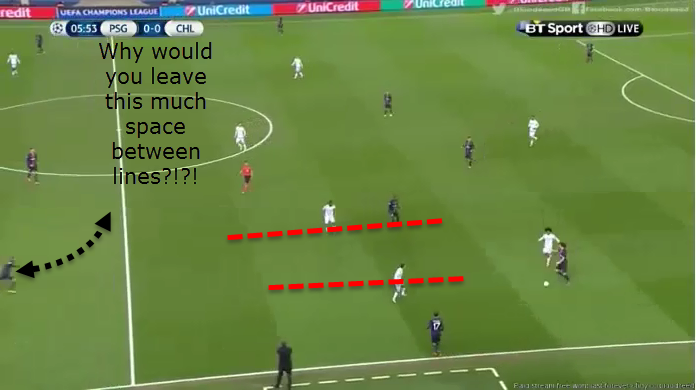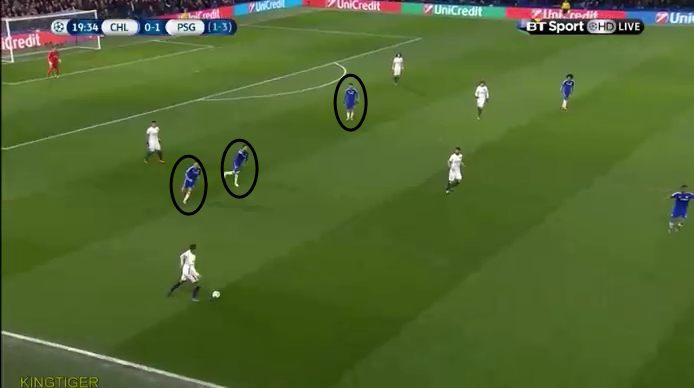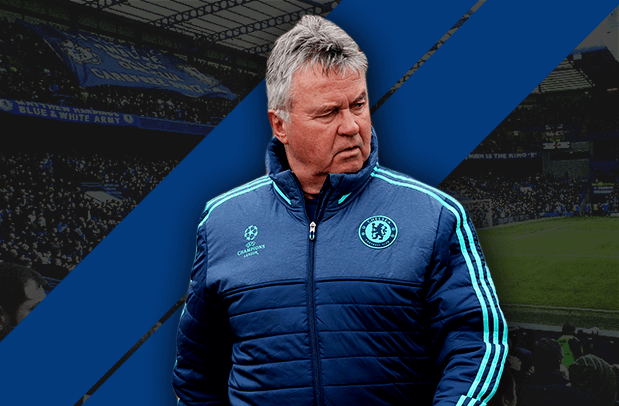James Sutherland writes in detail about the new found pressing tactic that Guus Hiddink has Chelsea playing.
Chelsea’s season is over. They went out of the League Cup in October, the Premier League title was gone months ago and the top four is pretty much out of reach now as well, and then, in the span of a week, the Blues went out of both the FA Cup and Champions League.
Although Chelsea has not lost in the league since Guus Hiddink took over from Jose Mourinho, Chelsea have been lackluster. The form has improved only slightly; the offense still struggles for great portions of games, and the defense is porous.

But one interesting thing has changed. Hiddink has, on several occasions, put a press into Chelsea’s game. It isn’t perfect, but it has proved pretty successful for Chelsea. Let’s look at three games to see how the press works.
16 February vs. PSG (Champions League 1st Leg)
This was the first glimpse that we got of Chelsea playing a press. It was rough and fairly passive (relative to the other games we’ll see; none of these are exactly shining examples of a good press), and was far too easy for PSG to beat.

Here is an early example of Chelsea’s high press. David Luiz receives the ball from Kevin Trapp, in the left half space. Chelsea are lined up in a rough 4-4-2 (the usual defensive formation for Chelsea), although Willian would occasionally drop off the first line to make a 4-4-1-1.
Look at the complete lack of pressure on Luiz, once of the best attacking center backs in the world, in the left half space; no one is within 15 yards of him. Chelsea seem to be man oriented here, but, as we will see later, it isn’t rigid.

To make things worse, Chelsea allow Luiz to dribble for 20 yards, unopposed, in the half space. Willian applies pressure far too late, as Luiz is releasing his pass. Furthermore, Pedro and Mikel have done little to close down the open passing lane, leaving tons of space for Luiz to pass into.
On top of all that, look at the space between midfield and defense: you can’t even see the backline in this photo. If you’re going to play a high midfield and attack, the defense has to follow, or else you’ll leave room for the opposition to play in-between lines.

That’s exactly what happens. Luiz’s pass rolls all the way to Zlatan, who was given far too much space by Chelsea’s center backs. Lucas’ run isn’t checked by Azpilicueta, allowing for Zlatan to lay off the ball too him. Now Chelsea’s backline is on its heels, with a very good counter attacking team on the hunt.

Here is another example of the weak Chelsea press. PSG has won the ball deep in its own half, and although the Blues apply some nominal pressure to stop a quick counter, it is nowhere near enough to impede the break.
Chelsea are left with 3 midfielders, all backtracking, facing 5 PSG players. This wouldn’t be such a problem if the 3 Chelsea players behind the ball were hustling back, or at least applying pressure, but instead they are standing and watching.

PSG advance the ball once again unimpeded, and once again have a wide open passing lane. Notice how preoccupied Ivanovic is with Zlatan; he is so sure that the pass is going to Zlatan that he doesn’t even think to check Lucas’ run behind.
The space between Mikel and Cesc is simply unacceptable. It’s one thing to leave a passing lane open on a wing or half space, but to do so in the middle of the field is absolutely horrendous.

The pass makes it past two lines of Chelsea’s defense, and hits Lucas right in his stride. If it wasn’t for Azpilicueta’s fantastic awareness and one-on-one defending, Lucas would have put PSG up a goal here.
Notice Ivanovic and Cahill’s positioning. They were caught totally off guard by the pass because they were so focused on Zlatan. They weren’t ready to move, and Lucas left them in the dust. This is where Chelsea encounter problems playing a press/nominal high line; none of their potential center backs, aside from Kurt Zouma, have the athleticism to play an aggressive, high line, and Zouma has nowhere near the positional sense to.
This was a mix of a poor counterpress and some good PSG combos, but shows our poor defensive strategy to allow that pic.twitter.com/u54D02OzSx
— James Sutherland (@thepitchview) February 19, 2016
In the above video, Chelsea do apply pressure, and are trying to put on a good counter press. It’s simply too easy for PSG to play out of Chelsea’s traps, and although they don’t advance the ball quickly out of it (and maybe this was Hiddink’s goal, more than win the ball back), it is indicative of the greater struggles of the game.
9 March vs. PSG (Champions League 2nd leg)
Three weeks later, Chelsea had their backs against the wall. Down a goal at home, and 3-1 on aggregate, they needed at least two goals to send the tie to extra time. Defying the odds (and my own expectations, to be honest), Chelsea nearly pulled it off. The most important factor in their near comeback was the use of an aggressive press/counter press to unsettle PSG.
The press in this game was much better than what we saw in the first leg. While still flawed and open, Chelsea compensated for the lack of structural discipline with remarkable intensity in chasing the ball, and were much more successful in forcing PSG deep into their own half.

Here Thiago Silva has the ball in the right half space, looking to progress the ball up the pitch. Chelsea are a bit out of shape here, because PSG have already had possession for 30 seconds, and Chelsea are only just then shifting sides. Eden Hazard is putting pressure on Silva, making the pass upfield hard, while the three Chelsea players in the middle cut that pass off. The only option is to pass to Marquinhos on the wing.

Marquinhos gets the ball on the wing, and has a good number of options up field. Notice the 3 Blues behind the ball. In the first leg, it wouldn’t have been surprising to see all 3 walk back up field. But instead, and this made the difference, both Fabregas and Hazard hustle back, closing down the ball.

Thiago Motta gets the ball from Marquinhos, and is shutdown by Chelsea. Fabregas pressures him from behind, while Mikel does a great job turning him towards the sideline. Kenedy steps out of the backline to stay tight with Di Maria, while Hazard is close enough to close Marquinhos down.
Also notice that if Motta had turned around, Matuidi was wide open in the middle. This is perhaps were Marco Veratti, PSG’s normal playmaker, was missed most.

Marquinhos has nowhere to play the ball but back to Silva.

Silva gets the ball back, and Costa applies good pressure on him, forcing him deeper into the corner. Look at where Silva is compared to his original position at the start of the play; Chelsea has forced him backwards, gradually, 15 yards.


Silva plays the ball to Rabiot, who quickly plays it on to Marquinhos. Throughout this, Chelsea keep pressure on PSG, limiting play forward. Finally Marquinhos makes a sloppy pass, and Hazard jumps it. Chelsea have the ball on the break, deep in PSG’s half, with the Parisians completely out of shape.
In addition to the good longer term press that Chelsea sustained (as seen above), the Blues also put on an aggressive counter press. While also flawed, it was intense, and combined with the hostile atmosphere, it shook PSG off their game.
Working on a piece on Hiddink’s press/counterpress and amazed by this clip pic.twitter.com/veCp8jVGhz
— James Sutherland (@thepitchview) March 22, 2016
In that video you can see the intensity of the counterpress. This clip leads to Chelsea’s equalizer, and while not every use of the counterpress even won the ball back for the Blues, it was much more successful in stopping PSG’s build up then the strategy Hiddink used in the first leg.
March 19 vs. West Ham (Premier League)
The press could be seen again in Chelsea’s Premier League match against West Ham.

Here we can see the flaws in Chelsea’s press once again. Although the team is playing higher up the field, they are defending somewhat passively. No one is within 10 yards off the ball, and to make things worse, they haven’t fully shut down all of the passing options. The pass backwards to a center back is a desirable option, so it makes sense to leave it open. But the fullback on the other side of the field shouldn’t as open as he is, and although Mikel is close to the midfielder, there is too much space behind the front 3 of Chelsea’s defense for him to move in.
West Ham do try to make that pass through the midfield, and it would have opened Chelsea up if not for the fact that the pass was very poor. Chelsea win the ball back, but immediately give it back to West Ham for a goalkick.

Adrian puts the ball back in from the goalkick, and Chelsea begin to more effectively apply pressure. Kenedy sticks with the fullback, while Willian cover shadows the other centerback, and moves to close down Adrian in goal. Oscar, meanwhile, is *slowly* closing down the man on the ball.

Adrian receives a pretty poor pass on his own touchline. Oscar stays with the centerback, and Willian continues his run to press Adrian. Notice the lack of follow up by the rest of Chelsea’s team; no one is behind Oscar and Willian, leaving open space for West Ham to exploit and break down Chelsea’s press.
West Ham, however, does not take advantage of this weak spot. Indeed, throughout this sequence, the Hammers have failed to exploit any of Chelsea’s weaknesses, bailing the Blues out on several occasions.

Instead of playing a ball between Willian and Oscar, into wide open space, Adrian foolishly chooses to hit the ball long. Mikel wins the ball back, and Chelsea regain possession.
Conclusion
Chelsea’s press is clearly very rough and incomplete. It has major structural issues, lacks spatial control and is pretty easy to beat when a team is smart. But, it should be an encouraging sign for Chelsea fans that the Blues are putting the press on, especially in the Premier League, where teams lack the basic tactical intelligence to pass out of the pressure. It is also a good starting point for whoever the next coach is (almost certainly Antonio Conte) to build off of. Although there is little left in the season for Chelsea, it should be interesting to watch how the press grows and improves.
Written by James Sutherland.
- Tactical Analysis: Sevilla 2-1 Real Madrid | Sevilla finally end the unbeaten streak - January 21, 2017
- Tactical Analysis: Borussia Dortmund 8-4 Legia Warsaw | Defence thrown out of the windows - November 27, 2016
- Tactical Analysis: RB Leipzig 1-0 Borussia Dortmund | Leipzing outpress Dortmund - September 18, 2016

























































